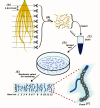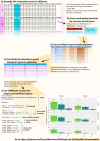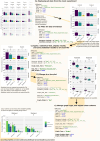Efficiently recording and processing data from arbuscular mycorrhizal colonization assays using AMScorer and AMReader
- PMID: 38828215
- PMCID: PMC11140075
- DOI: 10.3389/fpls.2024.1405598
Efficiently recording and processing data from arbuscular mycorrhizal colonization assays using AMScorer and AMReader
Abstract
Arbuscular mycorrhizal (AM) fungi engage with land plants in a widespread, mutualistic endosymbiosis which provides their hosts with increased access to nutrients and enhanced biotic and abiotic stress resistance. The potential for reducing fertiliser use and improving crop resilience has resulted in rapidly increasing scientific interest. Microscopic quantification of the level of AM colonization is of fundamental importance to this research, however the methods for recording and processing these data are time-consuming and tedious. In order to streamline these processes, we have developed AMScorer, an easy-to-use Excel spreadsheet, which enables the user to record data rapidly during from microscopy-based assays, and instantly performs the subsequent data processing steps. In our hands, AMScorer has more than halved the time required for data collection compared to paper-based methods. Subsequently, we developed AMReader, a user-friendly R package, which enables easy visualization and statistical analyses of data from AMScorer. These tools require only limited skills in Excel and R, and can accelerate research into AM symbioses, help researchers with variable resources to conduct research, and facilitate the storage and sharing of data from AM colonization assays. They are available for download at https://github.com/EJarrattBarnham/AMReader, along with an extensive user manual.
Keywords: AMReader; AMScorer; arbuscular mycorrhizal fungi; microscopy; root length colonization.
Copyright © 2024 Jarratt-Barnham, Oldroyd and Choi.
Conflict of interest statement
The authors declare that the research was conducted in the absence of any commercial or financial relationships that could be construed as a potential conflict of interest.
Figures






Similar articles
-
VBA-AMF: A VBA Program Based on the Magnified Intersections Method for Quantitative Recording of Root Colonization by Arbuscular Mycorrhizal Fungi.Indian J Microbiol. 2020 Sep;60(3):374-378. doi: 10.1007/s12088-020-00866-7. Epub 2020 Apr 10. Indian J Microbiol. 2020. PMID: 32647395 Free PMC article.
-
Insights on the Impact of Arbuscular Mycorrhizal Symbiosis on Eucalyptus grandis Tolerance to Drought Stress.Microbiol Spectr. 2023 Mar 16;11(2):e0438122. doi: 10.1128/spectrum.04381-22. Online ahead of print. Microbiol Spectr. 2023. PMID: 36927000 Free PMC article.
-
Split down the middle: studying arbuscular mycorrhizal and ectomycorrhizal symbioses using split-root assays.J Exp Bot. 2022 Mar 2;73(5):1288-1300. doi: 10.1093/jxb/erab489. J Exp Bot. 2022. PMID: 34791191 Review.
-
Role of Arbuscular Mycorrhizal Fungi in Regulating Growth, Enhancing Productivity, and Potentially Influencing Ecosystems under Abiotic and Biotic Stresses.Plants (Basel). 2023 Aug 29;12(17):3102. doi: 10.3390/plants12173102. Plants (Basel). 2023. PMID: 37687353 Free PMC article. Review.
-
Caesium inhibits the colonization of Medicago truncatula by arbuscular mycorrhizal fungi.J Environ Radioact. 2015 Mar;141:57-61. doi: 10.1016/j.jenvrad.2014.12.001. Epub 2014 Dec 23. J Environ Radioact. 2015. PMID: 25540940
References
-
- Alteio L. V., Séneca J., Canarini A., Angel R., Jansa J., Guseva K., et al. . (2021). A critical perspective on interpreting amplicon sequencing data in soil ecological research. Soil Biol. Biochem. 160, 1–3. doi: 10.1016/j.soilbio.2021.108357 - DOI
LinkOut - more resources
Full Text Sources

